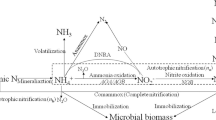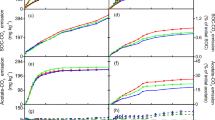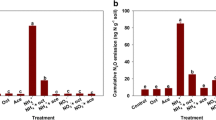Abstract
Purpose
Acetylene (C2H2) is employed for the quantification of important biological processes such as nitrogen fixation, nitrous oxide reduction, ammonium and methane oxidation, and methanogenesis. Although acetylene is not a natural product, the ability of bacteria to grow on C2H2 is a phenomenon common to soils and sediments. Our experiment was designed to study the modification of CO2 production, O2 uptake and microbial biomass (Cmic) in soil in response to the consumption of added acetylene.
Materials and methods
Two soils (peat-muck and Eutric Cambisol) were incubated under well aerated (60% water holding capacity [WHC]) or flooded conditions, and enriched with C2H2 in the range 0.1–10 kPa (initially, 0.434–63.4 mmol C2H2 kg−1) at a constant temperature of 20°C. Gases were measured chromatographically, while Cmic was measured by the physiological SIR (substrate-induced respiration) method based on the initial response of microorganisms to glucose amendment. We used a simple calculation of net CO2, net O2 and net Cmic (as differences between amended and not amended soils) to estimate the contribution of C2H2 to the total respiration and microbial growth during the incubation.
Results and discussion
Peat-muck soil consumed more C2H2 than Cambisol (maximum 54.03 vs. 19.25 mmol kg−1, p < 0.001). Acetylene utilization was faster and larger in flooded than in wet soils (16.2 and 7.81 mmol kg−1, respectively, p < 0.05), and followed the tendency observed for Cmic. Depending on C2H2 enrichment, air–water conditions, and soil tested, both reduction and stimulation of measured activities were observed in response to acetylene consumption. Low C2H2 uptake, especially in Cambisol incubated at 60% WHC, resulted in the reduction of soil respiration and biomass (by 1–29%). Large C2H2 consumption in flooded soils stimulated CO2 production, O2 uptake and Cmic, even by 78%, 72% and 43%, respectively. Net CO2, net O2, and net Cmic were linearly positively related to the quantity of consumed C2H2 (p < 0.001).
Conclusions
Acetylene utilization was a combined effect of initial C2H2, soil properties, and air–water status. The amount of consumed C2H2 was the highest in flooded peat-muck soil enriched with 10 kPa, and lowest in Cambisol at 60% WHC with 0.1 kPa C2H2. Consumption of 1 mol acetylene induced production of 0.5 mol CO2, and uptake of 0.4 mol O2. Low acetylene consumption (<6 mmol kg−1) resulted in reduction of both soil respiration and microbial biomass.





Similar content being viewed by others
References
Anderson JPE, Domsch KH (1978) A physiological method for the quantitative measurement of microbial biomass in soils. Soil Biol Biochem 10:215–221
Antić-Mladenović S, Rinklebe J, Frohne T, Stärk H-J, Wennrich R, Tomić Z, Ličina V (2011) Impact of controlled redox conditions on nickel in a serpentine soil. J Soils Sediments 11:406–415
Bauhus J, Paré D, Coté L (1998) Effects of tree species, stand age and soil type on soil microbial biomass and its activity in a southern boreal forest. Soil Biol Biochem 30:1077–1089
Belay N, Daniels L (1987) Production of ethane, ethylene, and acetylene from halogenated hydrocarbons by methanogenic bacteria. Appl Environ Microbiol 53:1604–1610
Birch-Hirschfeld L (1932) Die Umsetzung von Acetylen durch Mycobacterium lacticola. Zbl Bakt II Natur 86:113–130
Brouzes R, Knowles R (1971) Inhibition of growth of Clostridium pasteurianum by acetylene, implication for nitrogen fixation assay. Can J Microbiol 17:1483–1489
Brzezińska M (2006) Impact of treated wastewater on biological activity and accompanying processes in organic soils (field and model experiments) (in Polish, English summary). Acta Agrophy, Ser Monogr 131:7–164
Brzezińska M, Stępniewska Z, Stępniewski W (1998) Soil oxygen status and dehydrogenase activity. Soil Biol Biochem 30:1783–1790
Brzezińska M, Sokołowska Z, Alekseeva T, Alekseev A, Hajnos M, Szarlip P (2011) Some characteristics of organic soils irrigated with municipal wastewater. Land Degrad Dev, doi:10.1002/ldr.1036
Chan ASK, Parkin TB (2000) Evaluation of potential inhibitors of methanogenesis and methane oxidation in a landfill cover soil. Soil Biol Biochem 32:1581–1590
Conrad R (1996) Soil microorganisms as controllers of atmospheric trace gases (H2, CO, CH4, N2O, and NO). Microbiol Rev 60:609–640
Crounse JD, DeCarlo PF, Blake DR, Emmons LK, Campos TL, Apel EC, Clarke AD, Weinheimer AJ, McCabe DC, Yokelson RJ, Jimenez JL, Wennberg PO (2009) Biomass burning and urban air pollution over the Central Mexican Plateau. Atmos Chem Phys 9:4929–4944
Culbertson CW, Zehnder AJB, Oremland RS (1981) Anaerobic oxidation of acetylene by estuarine sediments and enrichment cultures. Appl Environ Microbiol 41:396–403
Culbertson C, Strohmaier FE, Oremland RS (1988) Acetylene as a substrate in the development of primordial bacterial communities. Orig Life Evol Biosph 18:397–407
de Bont JAM, Peck MWP (1980) Metabolism of acetylene by Rhodococcus AI. Arch Microbiol 127:99–104
DFG–Priority Programme 1319 (2010) Biological transformations of hydrocarbons without oxygen: from the molecular to the global scale. First Meeting, 08–10 March, 2010. Schloss Machern/Leipzig. Boll M, Meckenstock RU (org). http://www.helmholtz-muenchen.de/fileadmin/SPP1319/PDF/Abstractband_DFG_Tagung_2010__3_.pdf. Accessed 14 April 2011
Didriche K, Herman M (2010) A four-atom molecule at the forefront of spectroscopy, intramolecular dynamics and astrochemistry: acetylene. Chemi Phys Lett 496:1–7
Einsle O, Niessen H, Abt DJ, Seiffert G, Schink B, Huber R, Messerschmidt A, Kroneck PMH (2005) Crystallization and preliminary X-ray analysis of the tungsten-dependent acetylene hydratase from Pelobacter acetylenicus. Acta Crystallogr F61:299–301
Flather DH, Beauchamp EG (1992) Inhibition of the fermentation process in soil by acetylene. Soil Biol Biochem 24:905–911
Franzluebbers AJ (1999) Microbial activity in response to water-filled pore space of variably eroded southern Piedmont soils. Appl Soil Ecol 11:91–101
Gejlsbjerg B, Andersen TT, Madsen T (2004) Mineralization of organic contaminants under aerobic and anaerobic conditions in sludge–soil mixtures. J Soils Sediments 4:30–36
Germon JC, Knowles R (1988) Metabolism of acetylene and acetaldehyde in Rhodococcus rhodochrous. Can J Microbiol 34:242–248
Gliński J, Stępniewski W (1985) Soil aeration and its role for plants. CRC, Boca Raton
Goldman JD (1928) Conclusions from extended experiments with nitrous oxide, acetylene, ethylene oxygen anesthesias. Br J Anaesth 6:57–60
House AJ, Hyman MR (2010) Effects of gasoline components on MTBE and TBA cometabolism by Mycobacterium austroafricanum JOB5. Biodegradation 21:525–541
HPA, Compendium of Chemical Hazards, Acetylene (2009) Foxall K, Health Protection Agency, Version 1. http://www.hpa.org.uk/web/HPAwebFile/HPAweb_C/1246260034064. Accessed 29 April 2011
Inubushi K, Brookes PC, Jenkinson DS (1991) Soil microbial biomass C, N and ninhydrin-N in aerobic and anaerobic soils measured by the fumigation–extraction method. Soil Biol Biochem 23:737–741
Inubushi K, Sugii H, Watanabe I, Wassmann R (2002) Evaluation of methane oxidation in rice plant–soil system. Nutr Cycl Agroecosyst 64:71–77
Inubushi K, Sakamoto K, Sawamoto T (2005) Properties of microbial biomass in acid soils and their turnover. Soil Sci Plant Nutr 51:605–608
Inubushi K, Cheng W, Mizuno T, Lou Y, Hasegawa T, Sakai H, Kobayashi K (2011) Microbial biomass carbon and methane oxidation influenced by rice cultivars and elevated CO2 in a Japanese paddy soil. European J Soil Sci 62:69–73
Kanakidou M, Bonsang B, Le Roulley JC, Lambert G, Martin D, Sennequier G (1988) Marine source of atmospheric acetylene. Nature 333:51–52
Kanner D, Bartha R (1979) Growth of Nocardia rhodochrous on acetylene gas. J Bacteriol 139:225–230
Kanner D, Bartha R (1982) Metabolism of acetylene by Nocardia rhodochrous. J Bacteriol 150:989–992
Kęsik T, Błażewicz-Woźniak M, Wach D (2010) Influence of conservation tillage in onion production on the soil organic matter content and soil aggregated formation. Int Agrophys 24:267–273
Klemedtsson LK, Mosier AR (1994) Effect of long-term field exposure of soil to acetylene on nitrification, denitrification, and acetylene consumption. Biol Fertil Soils 18:42–48
Klemedtsson L, Hansson G, Mosier A (1990) The use of acetylene for the quantification of N2 and N2O production from biological processes in soil. In: Revsbech NP, Sørensen J (eds) Denitrification in soil and sediment. Plenum, New York, pp 167–180
Liang X, Philp RP, Butler EC (2009) Kinetic and isotope analyses of tetrachloroethylene and trichloroethylene degradation by model Fe(II)-bearing minerals. Chemosphere 75:63–69
Liao R-Z, Yu J-G, Himo F (2010) Mechanism of tungsten-dependent acetylene hydratase from quantum chemical calculations. Proc Natl Acad Sci USA 107:22523–22527
Linn DM, Doran JW (1984) Effect of water-filled pore space on carbon dioxide and nitrous oxide production in tilled and nontilled soils. Soil Sci Soc Am J 48:1667–1672
Mozharova NV, Kulachkova SA (2008) Specificity of soil functioning and formation on gas-bearing areas. J Soils Sediments 8:424–432
Oremland RS, Voytek MA (2008) Acetylene as fast food: implications for development of life on anoxic primordial earth and in the outer solar system. Astrobiology 8:45–58
Payne WJ, Grant MA (1982) Influence of acetylene on growth of sulfate-respiring bacteria. Appl Environ Microbiol 43:727–730
Rinklebe J, Langer U (2010) Relationship between soil microbial biomass determined by SIR and PLFA analysis in floodplain soils. J Soils Sediments 10:4–8
Rosner BM, Schink B (1995) Purification and characterization of acetylene hydratase of Pelobacter acetylenicus, a tungsten iron–sulfur protein. J Bacteriol 177:5767–5772
Rosner BM, Rainey FA, Kroppenstedt RM, Schink B (1997) Acetylene degradation by new isolates of aerobic bacteria and comparison of acetylene hydratase enzymes. FEMS Microbiol Lett 148:175–180
Ryżak M, Bieganowski A (2010) Determination of particle size distribution of soil using laser diffraction—comparison with areometric method. Int Agrophys 24:177–181
Schink B (1985) Fermentation of acetylene by an obligate anaerobe, Pelobacter acetylenicus sp. nov. Archiv Microbiol 142:295–301
Seiffert GB, Ullmann GM, Messerschmidt A, Schink B, Kroneck PMH, Einsle O (2007) Structure of the non-redox-active tungsten/[4Fe:4S] enzyme acetylene hydratase. PNAS 104:3073–3077
Selivanovskaya SY, Latypova VZ (2003) The use of bioassays for evaluating the toxicity of sewage sludge and sewage sludge-amended soil. J Soils Sediments 3:85–92
Serrano-Silva N, Luna-Guido M, Fernández-Luqueno F, Marsch R, Dendooven L (2011) Emission of greenhouse gases from an agricultural soil amended with urea: a laboratory study. Appl Soil Ecol 47:92–97
Siczek A, Lipiec J (2011) Soybean nodulation and nitrogen fixation in response to soil compaction and surface straw mulching. Soil Till Res 114:50–56
Singh KP, Malik A, Singh VK, Sinha S (2006) Multi-way data analysis of soils irrigated with wastewater–a case study. Chemometr Intell Lab Syst 83:1–12
Smith KA, Bremner JM, Tabatabai MA (1973) Sorption of gaseous atmospheric pollutants by soils. Soil Sci 116:313–319
Stępniewski W (2011) Aeration of soils and plants. In: Gliński J, Horabik J, Lipiec J (eds) Encyclopedia of agrophysics. Springer Science+Business Media, Dordrecht, pp 8–13
Stępniewski W, Stępniewska Z, Bennicelli RP, Gliński J (2005) Oxygenology in outline. Institute of Agrophysics PAS, Lublin. ISBN 83-89969-00-9
Tam TY, Mayfield CI, Inniss WE (1983) Aerobic acetylene utilization by stream sediment and isolated bacteria. Curr Microbiol 8:165–168
Terry RE, Duxbury JM (1985) Acetylene decomposition in soils. Soil Sci Soc Am J 49:90–94
Topp E, Germon J-C (1986) Acetylene metabolism and stimulation of denitrification in an agricultural soil. Appl Environ Microbiol 52:802–806
Wang B, Shao M, Lu SH, Yuan B, Zhao Y, Wang M, Zhang SQ, Wu D (2010) Variation of ambient non-methane hydrocarbons in Beijing city in summer 2008. Atmos Chem Phys 10:5911–5923
Watanabe I, de Guzman MR (1980) Effect of nitrate on acetylene disappearance from anaerobic soil. Soil Biol Biochem 12:193–194
Włodarczyk T, Stępniewski W, Brzezińska M (2002) Dehydrogenase activity, redox potential, and emission of carbon dioxide and nitrous oxide from Cambisols under flooding conditions. Biol Fertil Soils 36:200–206
Wrage N, van Groenigen JW, Oenema O, Baggs EM (2005) A novel dual-isotope labelling method for distinguishing between soil sources of N2O. Rapid Commun Mass Spectrom 19:3298–3306
Xiao Y, Jacob DJ, Turquety S (2007) Atmospheric acetylene and its relationship with CO as an indicator of air massage. J Geophys Res 112:d12305
Xu XK, Inubushi K (2005) Mineralization of nitrogen and N2O production potentials in acid forest soils under controlled aerobic conditions. Soil Sci Plant Nutr 51:683–688
Xu XK, Inubushi K (2008) Measurement of ethylene and methane production in a temperate forest soil using inhibition of acetylene and carbon monoxide. Chin Sci Bull 53:1087–1093
Xu XK, Inubushi K (2009a) Ethylene oxidation, atmospheric methane consumption, and ammonium oxidation in temperate volcanic forest soils. Biol Fertil Soils 45:265–271
Xu XK, Inubushi K (2009b) Temperature effects on ethylene and methane production from temperate forest soils. Chin Sci Bull 54:1426–1433
Xu XK, Inubushi K, Sakamoto K (2006) Effect of vegetations and temperature on microbial biomass carbon and metabolic quotients of temperate volcanic forest soils. Geoderma 136:310–319
Zhang TY, Xu XK, Luo XK, Han L, Wang YH, Pan GX (2009) Effects of acetylene at low concentrations on nitrification, mineralization and microbial biomass nitrogen concentrations in forest soils. Chin Sci Bull 54:296–303
Acknowledgements
The authors thank Mr. Michael Tregenza (Institute of Agricultural Medicine, Lublin, Poland) for improving the text (English correction) of this report.
Author information
Authors and Affiliations
Corresponding author
Additional information
Responsible editor: Zucong Cai
Electronic supplementary material
Below is the link to the electronic supplementary material.
ESM1
(DOC 90 kb)
Rights and permissions
About this article
Cite this article
Brzezińska, M., Rafalski, P., Włodarczyk, T. et al. How much oxygen is needed for acetylene to be consumed in soil?. J Soils Sediments 11, 1142–1154 (2011). https://doi.org/10.1007/s11368-011-0419-3
Received:
Accepted:
Published:
Issue Date:
DOI: https://doi.org/10.1007/s11368-011-0419-3




